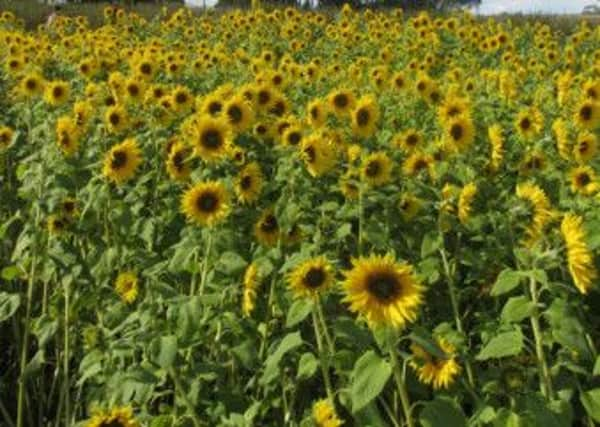Gardening: Growing your own flowers


Growing flowers in a garden is usually an activity designed to improve our outdoor living space with the plants providing a variety of colour and scents. Vegetables and fruit in an allotment or vegetable patch, on the other hand, are specifically planted to put food on the table.
When gardener, teacher and writer Sarah Raven sows her flower seeds however, it is done with the intention of harvesting her blossoms, as you would your lettuce or tomatoes, to bring some of the outside indoors.
Advertisement
Hide AdAdvertisement
Hide Ad“I think inside life is not the same without something living from outside in it,” she says. “It just really animates the room. I’ve always loved flowers and used to buy them and now I love them even more because I can just pick them.
“They’re expensive to buy and they have to be flown in from Kenya or South America so there’s lots of reasons that home-grown are the best.
“It’s the whole thing from the harvest, which is lovely – like getting eggs from the nesting boxes of your chickens right through to picking your own food, flowers are in that sort of realm. It’s incredibly satisfying and calming.”
Raven has written a book entitled The Cutting Garden which explains how to go about the process of planting flowers specifically for harvest.
It takes the reader through the different stages, from planning a whole garden, small patch or a mixed space to cultivating plants for different seasons and flower arranging.
The final part of the book has a catalogue of flowers and foliage through the seasons, divided according to colour from white and yellow to pink, red and purple plants. Raven’s interest in growing flowers for cutting started 20 years ago when she took maternity leave from her job as a medic and set up a florists with a friend in London.
“When I moved to the country I wanted to supply some of the flowers to the business,” says Raven, who lives between her farm in East Sussex and Sissinghurst Castle in Kent. “So when we moved to the farm I started growing a few things. I didn’t know anything about it, but that’s how I started.”
She began with annuals such as sunflowers, marigolds and cosmos and then moved onto dahlias.
Advertisement
Hide AdAdvertisement
Hide Ad“They give you huge productivity from very little space so they’re very good for square inch productivity which is what I’m really interested in,” she says.
“If you select the right ones they have good vase lives. They’re very good back-garden, hand-grown, cut flowers. You can’t beat them.”
The main considerations when planning a cutting garden are to choose a sunny spot with good soil because a lot will be demanded of a small area.
However, it doesn’t take a lot of space to grow flowers for cutting with a patch of three metres by four being adequate to start with.
“That’s a good starting space. That will fit 16 different varieties. If you then get hooked on it, which hopefully you will, you can always expand it a little bit.”
The cutting garden illustrated in the book is 12 x 24 metres and has eight planting areas with the four central beds used for plants that change throughout the seasons – with bulbs followed by annuals and biennials, and four L-shaped beds containing more permanent plantings of shrubs, climbers and herbaceous perennials.
Over the year, Raven grows 500 flowering plants in her cutting garden, including different varieties of tulips and dahlias.
“They are like an ever-filling cup if you grow the right ones and pick them in the right way. They just reflower and reflower and reflower. You can even do it in a pot and you’ve got just copious quantities of cut flowers to bring inside.”
Advertisement
Hide AdAdvertisement
Hide AdHer favourites are dahlias, Iceland poppies and highly-scented, rich-coloured sweet peas.
In the book, she says poppies are among the best flowers to grow for cutting with the biennial Iceland variety lasting for up to two weeks in a vase of water.
Every season offers a different range of flowers to cut and Raven gives advice on when and how to cut the flowers, what type of vase to choose and how to arrange the stems.
Even in winter, there are opportunities for creating fragrant and elegant displays. “In November, December, January and February, there’s less and you’re then relying quite a lot on forced bulbs – things like hyacinths in pots or crocuses in pots, that sort of thing,” says Raven. “However even in November, if you have a greenhouse, you can have chrysanthemums.”
Growing flowers for cutting can be done year-round and involves a little work, a lot of the time.
Spring is the busiest season, with mulching, pruning and tidying to be done.
Autumn is another busy period when the garden needs to be prepared for the cold season and bulbs planted out, and winter is the time to select seeds for the following year.
As she says in the introduction to the book, a lot of planning, preparation, patience and sheer hard work is necessary to create glorious flowers.
Advertisement
Hide AdAdvertisement
Hide AdHowever she adds: “You know the whole history of the flower that you are picking, you know what has gone into producing it. It is the culmination of a long haul which may well have begun the year before. The picking, in that sense, puts you in touch with nature in a way that simply looking at a flower that is growing in a garden could not.”
• The Cutting Garden, by Sarah Raven, is published by Frances Lincoln and costs £20.